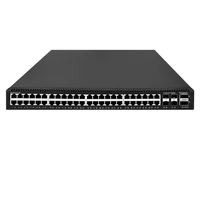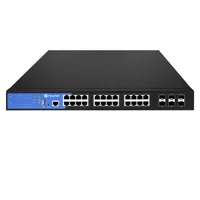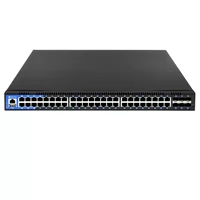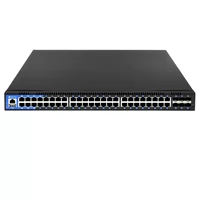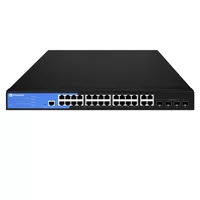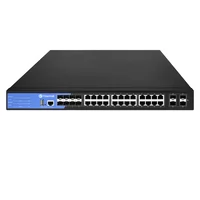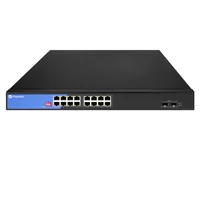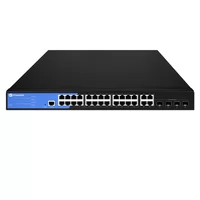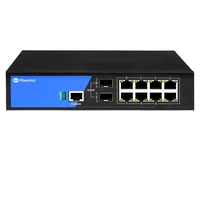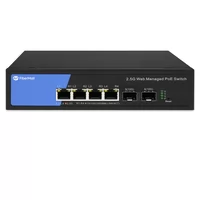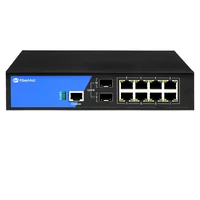Fiber optics has transformed contemporary network systems’ efficiency, dependability, and construction, owing to the sheer speed provided. Fiber optic switches are critical components of such structures for their ability to control the efficacy of information processing over sprawling tangled frameworks. This piece analyzes how these switches can make a difference today. We will explore how fiber optic switches aid in seamless scalability, network optimization, and meeting high bandwidth application and service demands. IT managers, network designers, and other technology stakeholders would find it pertinent to learn the impact of these devices owing to the dynamic nature of modern communication networks. Get ready to understand how fiber optic switches are catalyzing advancements and transforming connectivity across the globe.
Table of Contents
ToggleWhat is a Fiber Switch and How Does it Work?

A fiber switch is a networking device that manages and controls data traffic in a fiber optic network. It interfaces with various devices, including servers, computers, and storage systems, facilitating communication through optical fiber cables. Fiber switches accept data signals on one port, process the information, and then forward the data to the designated device address. These switches are prized for their low latency in handling large volumes of data. It is ideal for applications like data centers and enterprise networks that demand high bandwidth and reliable performance. Their design guarantees increased network efficiency and reduced signal loss, especially when combined with optical fiber switches.
Understanding the Basics of a Fiber Optic Switch
Fiber optic switches are classified as network devices responsible for controlling data transmission over fiber optic cables. They direct the incoming optical signal to the relevant output port to facilitate data flow through the optical fiber switch. These switches are distinguished by their ability to maintain high data speed, low signal interference, and long-range transmission. Their application is widespread in high-performance demanding scalable environments such as telecommunication systems, data centers, and advanced switched high-speed networks. Fiber optic switches serve an essential purpose in modern networking frameworks by accurately converting and routing optical signals.
The Role of Optical Fiber in Network Connectivity
Optical fibers have a fundamental significance in transmitting data over a network because of their ability to transmit large amounts of data at high speeds over great distances. Compared to copper cables, optical fibers transmit data via light, which minimizes interference and enhances data transmission speed. These features and the ability to improve capacity make optical fibers the most suited internet service providers, data centers, and other networks with high-performance demands. Furthermore, reliable, enduring communication, including protection against electromagnetic interference, enables superior security in data transfer.
Key Features of a Modern Network Switch
- High Port Density: With the latest models of network switches, port congestion is now a burden of the past as dozens of devices can be hooked up with near optimum efficiency.
- Gigabit and Multi-Gigabit Speed Support: These switches are crucial in enterprise networks since they offer data traffic above the usual threshold.
- Power over Ethernet (PoE): Power sourcing switches have the unique capability to power IP devices such as cameras and wireless access points, bypassing the heteronomy of power adapters.
- Advanced Security Features: Integrated security features such as Access Control Lists (ACLs) and port-based security simplify defense against unauthorized access and intrusion attempts on a network.
- VLAN Support: Virtual Local Area Networks (VLANs) separate circuits and resources, reducing congestion on a network and increasing its efficiency.
- Layer 3 Capabilities: The ability to manage traffic between VLANs and across the logical divisions of an enterprise network means many modern switches now include some level of routing.
- Energy Efficiency: Automated mode switches that change in response to the system’s level of activity greatly reduce operational costs.
- Ease of Management: Protocols such as SNMP, administration tools, and user guides contribute to effortless remote control of networks.
How to Choose the Right Ethernet Fiber Switch for Your Needs?
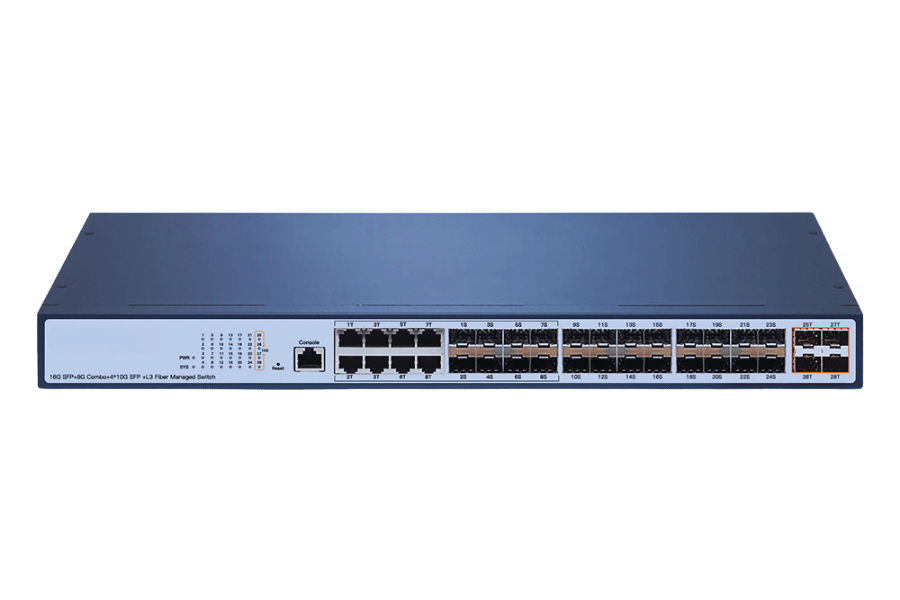
Evaluating Port Options: From 4 Port to 8 Port
When considering the options for Ethernet fiber switches, ports should be evaluated based on existing and future requirements. For smaller networks with a less complicated and less expensive configuration, a 4-port switch is offered for greater cost-efficiency. For growing networks that require additional support for increased devices, an 8-port switch is available, allowing for more scalability. In selecting a device, order fulfillment, current and expected traffic, and device amounts should always be considered to ensure optimal selection. The best model always features reliability, eases network monitoring and management, and exponentially improves overall network performance.
Understanding Managed vs. Unmanaged Switches
Managed switches provide control and customization through advanced features such as network monitoring, VLANs, and traffic control, making it appropriate for more sophisticated or changing network settings. Unmanaged switches, in contrast, are essential plug-and-play devices that operate without any user setup. These switches are best for use in small-scale networks with little supervision or complex features. The selection of one over the other is determined by the level of complicated features the network requires, the total number of users, and the degree of administrative oversight.
Importance of Multimode and Single Fiber in Switch Selection
Understanding the differences between single-mode and multimode fiber options is essential when selecting the correct fiber optic solution for switches. Multimode fiber is commonly used in LANs and data centers as it supports shorter distances. These cables are cost-effective for distances under 500 meters because of their higher light dispersion and the ability to use multiple light modalities. With new standards like OM4 and OM5, multimode fiber technology has dramatically improved with the ability to support 100 Gb/s over short distances.
Single-mode fibers are designed for extensive data transmission over 10 km. Their lower core diameter greatly reduces attenuation and signal degradation, allowing for pristine data transmission over long distances. Single-mode fibers have wide uses in telecommunication, WANs, and even metropolitan systems that demand high-bandwidth data with low-lag thresholds.
The evolution of networking technologies and the increasing demand for speed and reduced latency continue to dictate the selection of Fiber Switches. For example, in 400 Gb/s Ethernet networks, single-mode fiber is used since it is aligned with new pole-standard guidelines. At the same time, multimode fiber is still an economical option for corporations focusing on lower physical periphery control, particularly those using unmanaged Ethernet switch solutions.
Purchasing decisions on multimode and single-mode fiber require careful consideration of several interrelated criteria, such as spending, the estimated scope of the network, and network scaling after initial deployment. Using a 16-port ethernet switch with preset transceivers, administrators need to assess the optimum link distance, wavelength, and transceiver used. A shift in focus to lower deployment ROI enables efficient matching of switch capabilities to fiber functionalities, fulfilling a broad range of contemporary and emerging network requirements.
What Are the Benefits of a Gigabit Ethernet Fiber Switch?
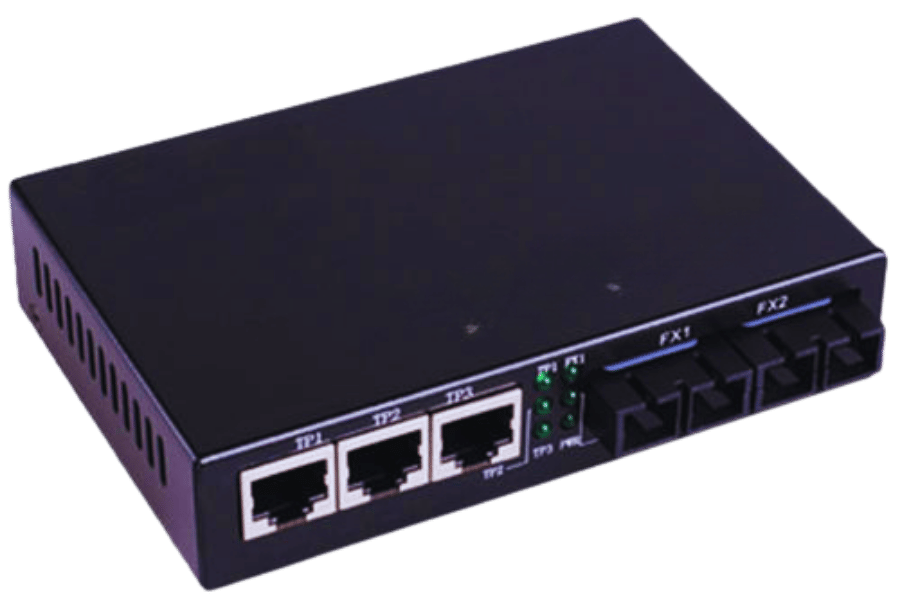
Enhancing Bandwidth and Data Transfer Rates
Communication within the devices is smoother and more efficient as Gigabit Ethernet fiber switches increase bandwidth and data transfer rates. In areas with heavy network traffic, modern workstations tend to have laser-focused workstations adept at high-speed data transfer and ensuring low latency and enhanced performance. Fiber optics offer many advantages. Compared to copper wires, these switches are optimal for data centers and enterprise networks. For this reason, these switches are helpful in modern data and bandwidth-intensive regions, along with the ability to maintain power over large distances.
Ensuring Seamless Connectivity in High-traffic Networks
To maintain continuous connectivity in dense traffic networks, sophisticated network management methods, and the latest hardware are essential. Modern high-performance switches have Advanced Quality of Service (QoS) settings, which assign the highest precedence to voice and video traffic, causing delays and packet loss to VoIP and streaming services. Industry benchmarks suggest that using Layer 3 switches with routing capabilities improves network practicality and effectiveness within enterprise environments.
Moreover, performance monitoring tools help track and resolve bottleneck issues in real-time. These tools can monitor flow, latency, and packet loss rate, enabling managers to operate effectively throughout the network, even during peak hours. Studies suggest that dynamic bandwidth allocation with load balancing can improve overall performance by 30% in cloud-integrated or IoT system-controlled environments.
Furthermore, 400 GbE (Gigabit Ethernet) standard switches, which are now featured in more advanced hardware offerings, solve problems related to high-bandwidth applications. These switches offer increased responsiveness and significantly enhanced data transfer rates for virtualization, big data analytics, and machine learning workloads. When integrated proactively, these technologies promise enhanced connectivity and a flexible architecture that can accommodate evolving network requirements, particularly with managed and unmanaged integration.
The Role of QoS in Traffic Management
The management of modern network traffic requires data prioritization for various applications and services, which is a hallmark of modern QoS or Quality of Service. Services considered mission-critical are protected through QoS techniques, which manage and classify network traffic to provide performance consistency, minimize packet loss, and ensure low latency. VoIP, video conferences, and interactive gaming have benefited from QoS technology advancements supporting real-time services.
QoS has been shown to increase significantly overall network performance as high-priority applications are performed without interruption during periods of network congestion. Bandwidth in QoS policies can be allocated dynamically to process latency-sensitive traffic with strict precedence. In contrast, lesser-priority services such as email or file downloads are adequately resourced. Proper QoS configuration and network monitoring tools have been shown in pilot studies to reduce downtime and disturbance through proper QoS configuration to boost overall enterprise system performance.
For scalability, SDN solutions are progressively being incorporated into QoS frameworks. This integration allows for dynamic traffic shaping and routing using real-time traffic pattern analysis. Such integrations guarantee resource allocation to the organization’s needs and strategies designed to avert obsolescence. QoS generally impacts traffic control, especially when monitoring data and time-sensitive processes.
How Do Managed Fiber Switches Enhance Network Security?
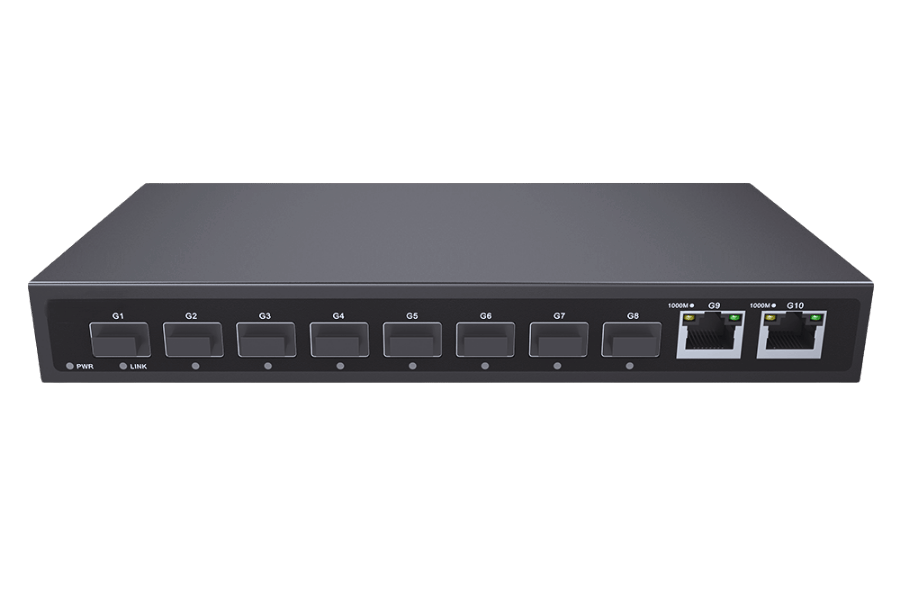
Implementing VLAN for Network Segmentation
VLANs bolster the security of a network by subdividing it into distinct parts, permitting administrators to manage traffic and control access between different areas of the network. Placing sensitive information or essential systems into separate VLANs reduces the risk of unauthorized access from other network sections, especially in fiber-switching environments. Also, VLANs help contain potential security hazards, such as malware or intrusions, by preventing them from infesting the entire network. This segmentation allows only specified users or devices to communicate in particular VLANs, thereby controlling access and improving the network’s overall security.
Utilizing SFP Transceivers for Secure Connections
SFP transceivers are indispensable for a network’s reliable and effective connection. These small modular interfaces provide various networking interfaces, allowing easy connection to routers, switches, and additional network equipment. SFP transceivers facilitate reliable data transmission through fiber optic cables over significant distances and have less risk of interference than copper cables. Furthermore, using SFP modules makes upgrades or replacements easier without significantly affecting network operations, enhancing infrastructural reliability and scalability. If appropriately configured, SFP modules improve substantially the performance of contemporary networks.
Advanced Routing Capabilities in Smart Switches
Advanced routing traffic management techniques can be effectively achieved using smart switches. These types of switches offer static routing, VLANs, and link aggregation, increasing network efficiency by optimizing data transfer. Enhanced smart switches provide added value by incorporating inter-VLAN routing, enabling streamlined communication between various network partitions without necessitating supplementary equipment, thereby improving switch capabilities. Moreover, the addition of Quality of Service (QoS) guarantees protection of prioritization for latency-sensitive applications such as VoIP and video streams. This makes smart switches an economical choice for contemporary scalable network infrastructures.
How to Integrate Fiber to Ethernet Solutions?

Using Ethernet Media Converters for Effective Transition
Ethernet media converters allow seamless integration of fiber optic cabling with Ethernet networks, facilitating effortless network expansion without sacrificing data transfer speed. To install these devices, plug the Ethernet cable from the network equipment, such as a switch or a router, directly into the media converter’s Ethernet port. Subsequently, the fiber cable must be connected to the media converter’s fiber port and the fiber network under consideration. Pay attention to the type of media converter you are using and check if you are using the right single-mode or multimode fiber. Also, ensure the correct fiber specifications, such as wavelength and distance. This simple step solves the problem of interfacing fiber and Ethernet connections for different network configurations, including industrial-grade fiber applications.
Setting Up PoE with Fiber Ethernet Connections
When installing Power over Ethernet with fiber Ethernet connections, you should do the following:
- Install a PoE Media Converter: Employ a media converter that merges PoE functions with fiber optics. This device combines data and power transmission over Ethernet.
- Connect the Fiber Optic Cable: Fix the fiber optic cable on the media converter’s fiber port. It should be of the right type (single-mode or multimode) and meet the requisite specifications for wavelength and distance.
- Connect the Ethernet Cable: Attach the Ethernet cable to the media converter’s Ethernet port and connect it to a powered device (IP camera, phone, or wireless access point). This allows the device to receive power and data.
- Provide Power to the Media Converter: Confirm the media converter is plugged into a suitable power source. Some models may allow a direct power input using DC power, while others require an external adapter.
The above example demonstrates using PoE media converters to integrate fiber networks with PoE devices, which allows easy long-distance data and power delivery.
Comparing Rack Mount and Stand-Alone Designs
The application, physical configuration, and scalability are the primary factors that differentiate rack mount designs from stand-alone ones. Large-scale deployments that require centralized management are better suited with rack mount designs. These designs allow multiple units stacked in a single rack, facilitating organization and saving space. They are commonly used in enterprise and data center environments. Conversely, self-contained units or stand-alone designs are more suitable for small-scale installations. These designs best serve situations where flexibility, portability, and low cost are priorities. Ethernet with no managed switches is used in these scenarios. The two designs differ based on the environment, scale, and specific network infrastructure requirements.
Frequently Asked Questions (FAQs)
Q: What is a fiber optic switch, and how does it benefit modern networks?
A: A fiber optic switch is a device type in which a fiber optic cable connects to a network using light to transmit data with high speed and bandwidth efficiency. Compared to traditional copper network switches, fiber optic switches significantly improve data transfer rates, reduce latency, and support high-demand applications by integrating into a fiber optic network.
Q: How does an ethernet switch differ from a fiber optic switch?
A: The primary difference between an ethernet switch and a fiber optic switch lies in the cables used for data transmission. An ethernet switch utilizes copper cables RJ45, while a fiber optic switch uses fiber optic cables. Because data rates and transmission distances are higher for fiber optic cables, fiber optic switches are more applicable to high-speed network environments.
Q: What is the role of a managed switch in a fiber optic network?
A: A managed switch provides remote configuration options for network elements, enabling administrators to influence network performance using a traffic monitoring system by prioritizing data streams through VLANs and Quality of Service (QoS) interfaces. In complex fiber networks, precision control is crucial, and thus, sophisticated designs are enabled.
Q: Is connecting a fiber optic switch with ethernet networks possible?
A: Fiber optic switches can be connected to ethernet networks using media converters that allow ethernet-to-fiber connections. This will enable networks to take advantage of fiber optics’ benefits while still using the pre-existing ethernet infrastructure.
Q: What are some benefits of using fiber gigabits in network configuration?
A: Gigabit fiber offers improved data transmission speeds, increased bandwidth, and reduced signal loss over long distances. It is ideal for high-performance applications, offers improved reliability in network operations, and supports the need for future expansion in data-intensive environments.
Q: What is the role of an optical switch, and how does it operate in a fiber optic network?
A: An optical switch interconnects various fiber networks, thereby linking different users and providers. It controls the paths of light in optical fibers to enhance signal integrity. This provides greater network adaptability due to the possibility of dynamic routing and switching without the need for signal conversion to electric form.
Q: In what ways does a smart managed switch improve the efficiency of network management?
A: A smart managed switch is a blend of unmanaged and managed switches. It offers control over essential management functions while remaining user-friendly. It allows monitoring and controlling traffic, improving network performance without requiring complicated configurations.
Q: Why are gigabit sfp ports so important within fiber optic switches?
A: Sapphire laser connectors’ versatility can broaden the network’s reach. The small form-factor pluggable (SFP) ports facilitate adding and removing various fiber and copper connections, increasing the usability of fiber optic switches in numerous network configurations.
Q: How do we provide redundancy in connection with the switch in a fiber optic network?
A: Redundancy is possible by configuring multiple managed switches with redundant data transmission paths. The spanning Tree Protocol (STP) leverages this redundancy attribute by providing active failure rerouting, enabling risk-free, uninterrupted network services.
Q: What are the most essential points you need to think about when procuring cables in fiber optics for a network?
A: The use of switches with fiber brings to attention the transmission rate and range, as well as the requirements of the area where they will be placed, to determine how these cables will be used. For long-distance communication, single-mode fibers would be preferred; however, multi-mode fibers would be better for shorter distances with high data rates.
Reference Sources
Related Products:
-
 S3100-48T2Q4X, 48-Port Ethernet Switch, 48x 10/100/1000/2500/10G BASE-T RJ45, with 2x 40G SFP+ and 4x 1G/10G SFP+ Uplinks
$1095.00
S3100-48T2Q4X, 48-Port Ethernet Switch, 48x 10/100/1000/2500/10G BASE-T RJ45, with 2x 40G SFP+ and 4x 1G/10G SFP+ Uplinks
$1095.00
-
 S3100-24T6X-P, 24-Port Ethernet Switch L3, PoE+ Switch, 24x 10/100/1000/2500 BASE-T RJ45, with 6x 1G/10G SFP+ Uplinks
$746.00
S3100-24T6X-P, 24-Port Ethernet Switch L3, PoE+ Switch, 24x 10/100/1000/2500 BASE-T RJ45, with 6x 1G/10G SFP+ Uplinks
$746.00
-
 S3100-48T6X-P, 48-Port Ethernet Switch L3, PoE+ Switch, 48x 10/100/1000BASE-T RJ45, with 6x 1G/10G SFP+ Uplinks
$734.00
S3100-48T6X-P, 48-Port Ethernet Switch L3, PoE+ Switch, 48x 10/100/1000BASE-T RJ45, with 6x 1G/10G SFP+ Uplinks
$734.00
-
 S3100-8T4X, 8-Port Ethernet Switch L3, 8x 10/100/1000/2500/10G BASE-T RJ45 Ports, with 4x 1G/10G SFP+ Uplinks
$398.00
S3100-8T4X, 8-Port Ethernet Switch L3, 8x 10/100/1000/2500/10G BASE-T RJ45 Ports, with 4x 1G/10G SFP+ Uplinks
$398.00
-
 S3100-48T6X, 48-Port Ethernet Switch L3, 48x 10/100/1000BASE-T RJ45, with 6x 1G/10G SFP+ Uplinks
$365.00
S3100-48T6X, 48-Port Ethernet Switch L3, 48x 10/100/1000BASE-T RJ45, with 6x 1G/10G SFP+ Uplinks
$365.00
-
 S2100-24T4TS-P, 24-Port Ethernet Switch L2+, PoE+ Switch, 24x 10/100/1000BASE-T RJ45, with 4x 1G RJ45/SFP Combo Uplinks
$360.00
S2100-24T4TS-P, 24-Port Ethernet Switch L2+, PoE+ Switch, 24x 10/100/1000BASE-T RJ45, with 4x 1G RJ45/SFP Combo Uplinks
$360.00
-
 S3100-16T8TS4X, 16-Port Ethernet Switch L3, 16x 10/100/1000BASE-T RJ45, with 8 x 1Gb RJ45/SFP Combo and 4 x 1Gb SFP Uplinks
$340.00
S3100-16T8TS4X, 16-Port Ethernet Switch L3, 16x 10/100/1000BASE-T RJ45, with 8 x 1Gb RJ45/SFP Combo and 4 x 1Gb SFP Uplinks
$340.00
-
 S2100-16T2S-P, 16-Port Ethernet Switch L2+, PoE+ Switch, 16x 10/100/1000BASE-T RJ45, with 2x 1G SFP Uplinks
$230.00
S2100-16T2S-P, 16-Port Ethernet Switch L2+, PoE+ Switch, 16x 10/100/1000BASE-T RJ45, with 2x 1G SFP Uplinks
$230.00
-
 S2100-24T4TS, 24-Port Ethernet Switch L2+, 24x 10/100/1000BASE-T RJ45, with 4x 1G RJ45/SFP Combo Uplinks
$148.00
S2100-24T4TS, 24-Port Ethernet Switch L2+, 24x 10/100/1000BASE-T RJ45, with 4x 1G RJ45/SFP Combo Uplinks
$148.00
-
 S2100-8T2S-P, 8-Port Ethernet Switch L2+, PoE+ Switch, 8x 10/100/1000BASE-T RJ45, with 2x 1G SFP Uplinks
$139.00
S2100-8T2S-P, 8-Port Ethernet Switch L2+, PoE+ Switch, 8x 10/100/1000BASE-T RJ45, with 2x 1G SFP Uplinks
$139.00
-
 S3100-4T2X-P, 4-Port Gigabit Ethernet Managed Switch, PoE+ Switch, 4x 10/100/1000/2500 BASE-T RJ45, with 2x 1G/10G SFP+ Uplinks
$90.00
S3100-4T2X-P, 4-Port Gigabit Ethernet Managed Switch, PoE+ Switch, 4x 10/100/1000/2500 BASE-T RJ45, with 2x 1G/10G SFP+ Uplinks
$90.00
-
 S2100-8T2S, 8-Port Ethernet Switch L2+, 8x 10/100/1000BASE-T RJ45, with 2x 1G SFP Uplinks
$71.00
S2100-8T2S, 8-Port Ethernet Switch L2+, 8x 10/100/1000BASE-T RJ45, with 2x 1G SFP Uplinks
$71.00
Related posts:
- Introducing the NVIDIA GH200: Revolutionary AI Supercomputing with the Grace Hopper Superchips
- Affordable Enterprise Ethernet Switches with 40Gb Data Transfer Rate – Available Now.
- Nvidia Quantum-2: Revolutionizing Infiniband Technology for Data Centers
- OSFP Connector: Ultimate Guide to Amphenol and TE Connectivity Solutions

